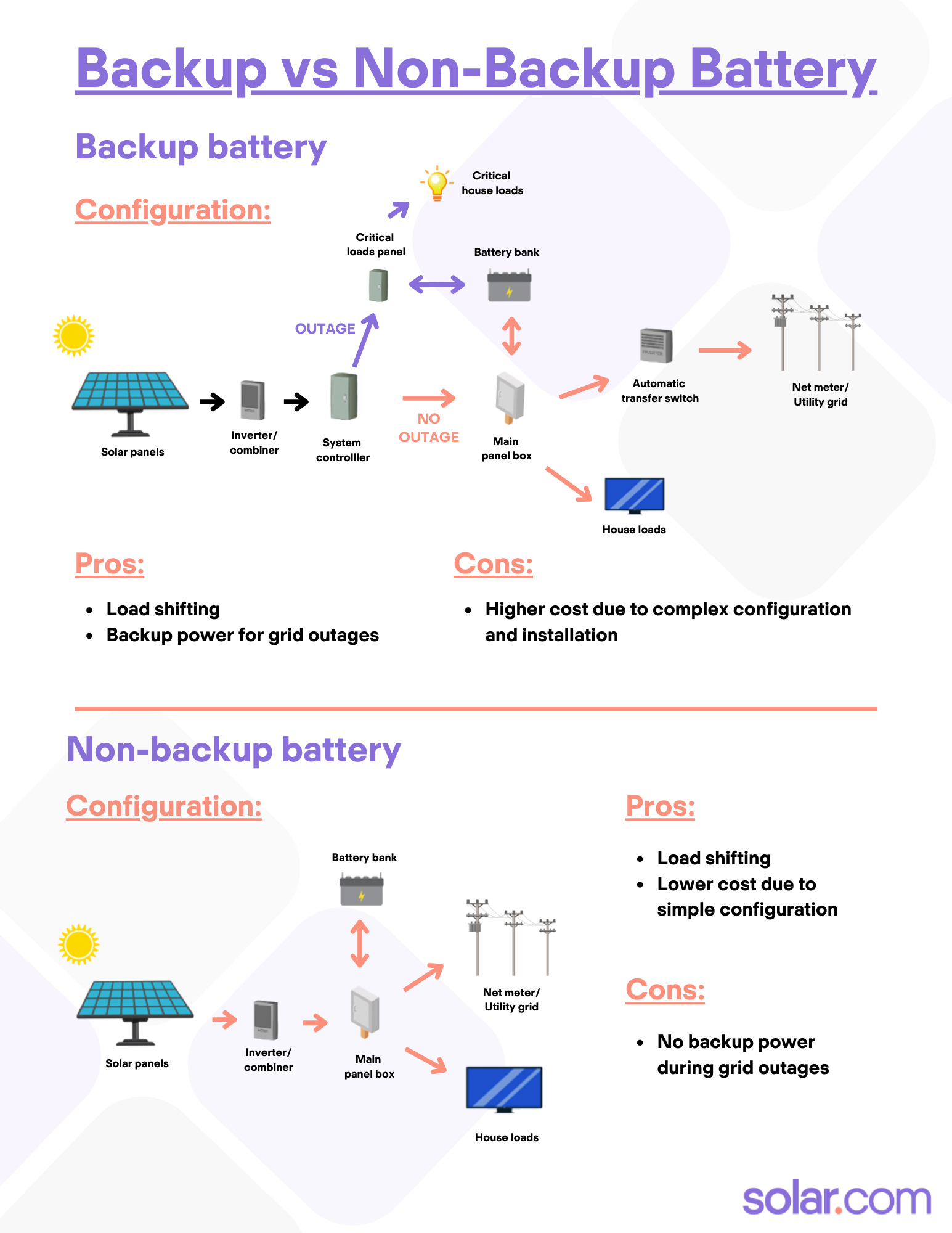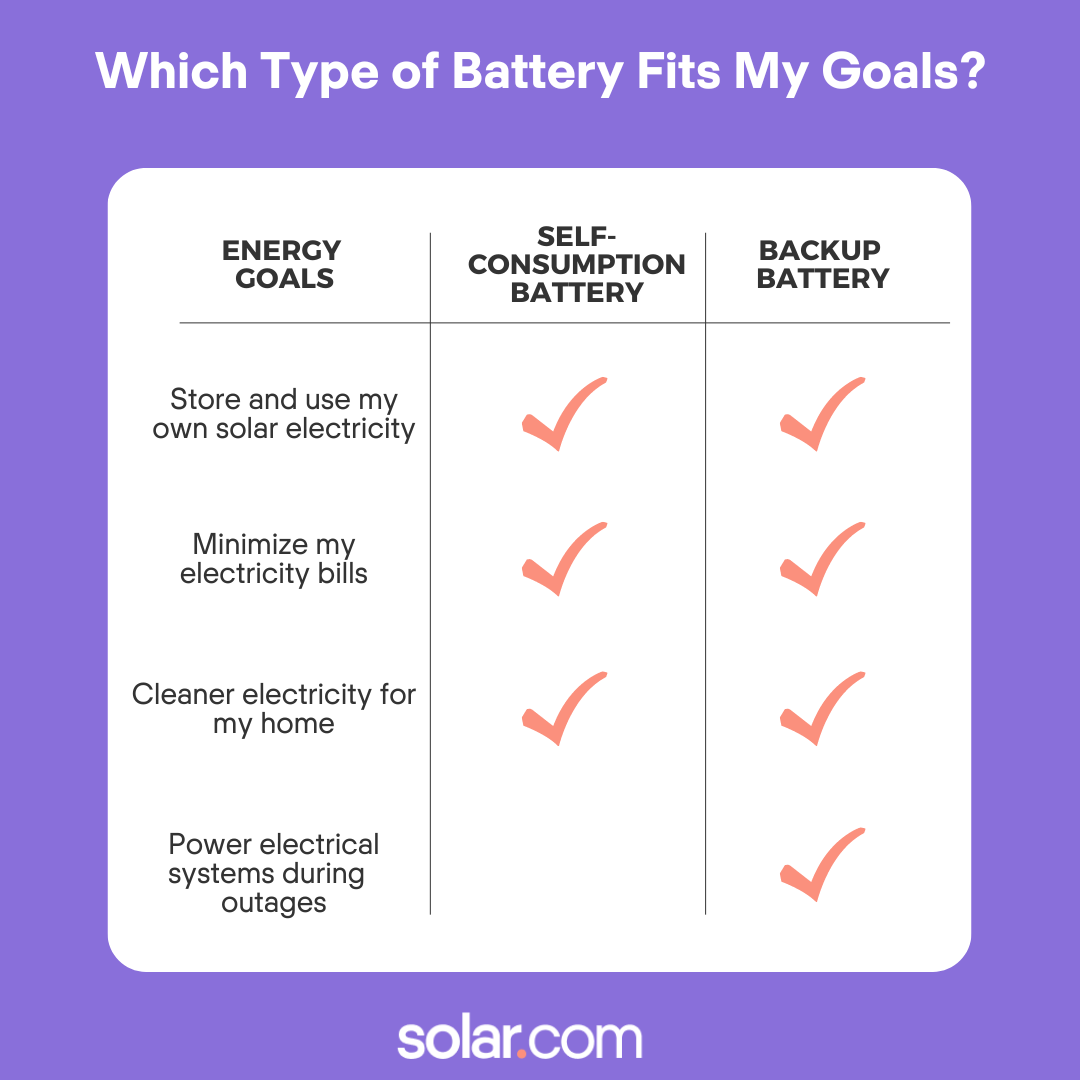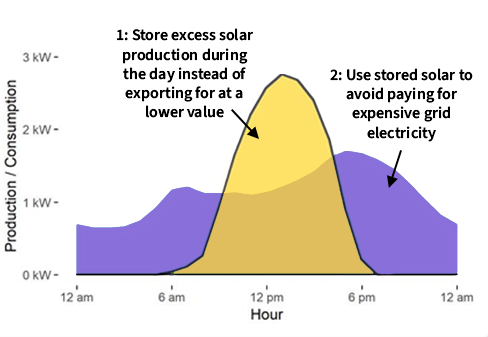
If you’re looking into solar to reduce your electricity costs in California, you may come across a new term that takes a second to digest: consumption-only battery
Consumption-only battery is one term for the new, more affordable generation of solar batteries that provide all the cost savings storing and using your own solar production, but do not have capability to provide backup power during grid outages.
You may also see this referred to as:
- No-backup batteries
- Grid-tied batteries
- Rate Saver batteries (or some version of this)
- Arbitrage batteries
- BatteryOne – just one calorie! (Okay, we made this one up)
Regardless of what you call it, a consumption-only battery is crucial to maximizing the savings potential of a home solar system billed under NEM 3.0.
We’re going to divide this article into two sections, both of which answer, “What’s the point of a battery that doesn’t provide backup power?”
Let’s start with the short version, but if at any point you need more details, then it’s time to jump to the long version below!
The quick version: What’s the point of a consumption-only battery?
Simply put, the point of a consumption-only battery is to maximize the savings of a NEM 3.0 solar system without paying for the additional (and rather expensive) backup capabilities of a traditional battery.
But why is battery storage so crucial for savings under NEM 3.0?
The key feature of NEM 3.0 solar billing is a drastic reduction in solar export rates – that’s the value of surplus solar electricity pushed onto the grid. With export rates slashed by 75% on average, it’s much more economical to store and consume your own solar production onsite than to export it to the grid.
That’s where battery storage comes in.
Home batteries have always had the ability to store solar energy produced during the day to use at night – a feature known as load shifting – but before NEM 3.0 billing, this feature was little more than a perk that saved the average household ~$30 a month. So, batteries were primarily associated with backup power instead of energy cost savings.
Under NEM 3.0, load shifting is crucial to bill savings (learn more in the in-depth version), but not every home needs – or wants to pay for – backup capabilities. Battery makers recognized this dilemma and said, “Okay, let’s set the backup components aside and offer just the load shifting.”
The cost of consumption-only versus backup batteries
As it turns out, there’s quite a bit of technology and labor that goes into enabling backup capabilities and removing these from the equation substantially reduces the cost of consumption-only batteries (learn more in the in-depth version).
In our experience so far, consumption-only batteries are being priced around $3,000 to $4,000 lower than their backup counterparts. This significantly reduces the cost barrier to battery technology and reduces the payback period of a NEM 3.0 solar and battery system.

Imagine if your cable TV provider allowed you to reduce the cost of your plan by 25-30% by removing 200 channels that you never watch. That’s pretty close to what’s happening with consumption-only batteries.
Which type of battery is right for me?
Under NEM 3.0 solar billing, the question has shifted from “Do I need a battery?” to “What type of battery do I need?”
But the answer remains the same: It depends on your energy goals.

- If you are strictly interested in energy cost savings, then a consumption-only battery is the way to go.
- If you regularly experience outages (or want to plan ahead), then a backup battery is a better fit.
It’s also worth considering the pros and cons of a consumption-only battery.
| Pros | Cons |
| Maximum savings for NEM 3.0 solar system | Does not provide backup power |
| Shorter payback period | Adding backup components later is more expensive than during initial installation |
| Not paying for features you may not use | May need to add capacity in order to provide robust backup capabilities later on |
| Quicker and easier installation | |
| Can add backup components later | |
| Storing and using your own solar production increases grid resiliency |
Connect with an Energy Advisor to talk through your battery options and to compare binding quotes for each option.
The in-depth version: Why are consumption-only batteries being offered in California?
Over the last decade or so, there have been two primary benefits for homeowners to install home battery systems:
- Backup power for grid outages
- Self-consumption of surplus clean energy
The backup component is pretty straightforward. Configuring a solar system with a battery allows the system to continue to operate during a power outage, providing uninterrupted power to the home. The battery will power the circuits it’s been configured to, and the panels will recharge the battery.
Historically, the consumption-only aspect of battery systems has been a much less potent motivator. For homeowners whose utility companies offer full 1:1 net metering, where electricity prices are the same at all times of day, using a battery for consumption-only doesn’t provide any additional savings. Some people appreciated the ability to use their own clean surplus power in the evening rather than drawing in dirty power from the grid, but there wasn’t really a financial incentive to do so.
Enter Time-of-Use rates
This paradigm began to shift when CA passed NEM 2.0 rates back in 2016. NEM 2.0 required homeowners to move to a time-of-use (TOU) rate plan when installing solar, which varies the price of electricity throughout the day. Under NEM 2.0, the rate for surplus power that a home solar system generated and sent back to the grid during the middle of the day (an “off-peak” period) became less than the cost of electricity drawn from the grid during the late afternoon & early evening (an “on-peak period”).
As a result, these TOU rates began providing a financial incentive to use the battery for consumption-only for the first time. Rather than exporting surplus power to the grid for lower credit and then being charged higher rates from the utility in the evening, using a battery to store surplus energy during the day and feed that same power into the house in the evening reduces the amount of power the home needs to draw from the grid at those higher peak rates.

In turn, the battery’s self-consumption capability helped reduced the remaining utility charges for the homeowner and yielded higher overall savings for a combined solar & battery system.
The value of this self-consumption capability is highly dependent on the difference in the rates throughout the day. The greater the difference between the rate for surplus power and the peak rate in the evening, the greater value the battery system will provide. Under NEM 2.0, the difference between the off-peak and on-peak rates wasn’t particularly high – maybe 20% or so.
So, even though the battery’s self-consumption capability would generate additional savings, it wasn’t hugely substantial – generally $30/month or so for the average project in CA – which means homeowners were still looking to batteries much more for power backup than for savings.
NEM 3.0 changes the game again
This is where CA’s new NEM 3.0 rates fundamentally change the equation. NEM 3.0 reduced the value of surplus power sent to the grid in the middle of the day by about 75% compared to NEM 2.0 levels.

With credits for daily surplus averaging around 7-8 cents per kWh and peak evening rates exceeding 50 cents/kWh, there is now about 80% less benefit to sending surplus energy back to the grid rather than storing it in a battery to use later. This makes each kilowatt-hour saved for self-consumption far more valuable than before, and allows battery systems to generate far higher returns.
Under these conditions, homeowners have begun expressing much more interest in batteries from a savings perspective, even if they don’t need the backup capability that standard battery installations provide.
So as long as you’re installing a battery to maximize your savings through consumption-only, why would you not just have the battery configured for backup as well?
Why not just install a standard backup battery?
The answer to this question is that configuring home batteries for backup requires thousands of dollars in additional costs, for both materials and labor, beyond the battery unit itself. In order for batteries to provide backup power, installation companies need to take on significant additional work, including:
- Running complex load calculations to determine how many circuits the battery system can accommodate for backup based on the specific demands on each of those circuits;
- Installing a subpanel that houses those specific circuits that have been determined to be included and running wires & conduit from the main panel;
- Relocating those designated breakers from the main electrical panel to the subpanel;
- Installing an automatic transfer switch that will allow the solar & battery system to disconnect from the grid when a power outage is detected to ensure live power isn’t backfed into the power lines;
- Increased complexity for both the permitting & installation processes
So, by configuring a battery system to only provide consumption-only on a daily basis, installation companies can offer the same amount of battery capacity for consumption-only savings at substantially lower cost – typically $3,000-4,000 – than the same battery system with all the additional work required for power backup.
This kind of consumption-only configuration wasn’t needed when backup power was really the sole reason to install a battery. Now, however, homeowners looking to maximize their bill savings who don’t particularly need backup power can get the same amount of savings that backup-configured systems can provide but at substantially lower cost.
Additionally, if grid reliability worsens over the coming years and homeowners decide they want to use their consumption-only battery for power backup, they have the flexibility to reconfigure that battery for backup down the road.
The bottom line
NEM 3.0 changed the solar landscape in California by reducing the benefits of solar-only systems and increasing the importance of batteries.
Consumption-only batteries are the solar industry’s response to NEM 3.0. By stripping out the backup power components, consumption-only batteries provide all the load shifting benefits of a traditional battery, but at a much lower price point.
Consumption-only batteries are a great option for homeowners that want to maximize their energy cost savings and aren’t frequently impacted by grid outages.
Connect with an Energy Advisor to discuss and compare your battery options.


